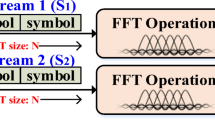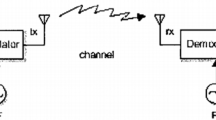Abstract
This paper presents the VLSI architecture of a highly-efficient and low-complexity Generalized Frequency Division Multiplexing (GFDM) receiver based on the joint Minimum Mean Square Error (joint-MMSE) approach. To be specific, a novel data processing flow is proposed in this paper where the bit reverse permutation after the FFT operation and the shuffle permutation are conducted concurrently. As a result, the processing delay is greatly reduced and the memory requirement for the temporary storage is saved. Based on the designed data flow, the VLSI architecture of the joint-MMSE GFDM receiver is presented. A novel folded structure is proposed so that the arithmetic and storage elements are utilized in a time-sharing manner and the area complexity is decreased. These elements are also architected with high configurability to support various processing modes. Moreover, a novel memory-access algorithm and address-generation circuit is designed to efficiently access the memory module and to mitigate the data conflict when supporting different processing modes. The proposed design is synthesized using TSMC 90 nm technology at operating frequency of 200 MHz. The post-synthesis estimation shows that this architecture occupies an area complexity of 492.6 kGEs. The analyses results illustrate that the proposed data flow leads to a 16% reduction in delay and complexity compared to the conventional approaches. Furthermore, the proposed design enhances the Efficiency by 4.7x compared to the state of the art work.














Similar content being viewed by others
References
Van De Beek, J., & Berggren, F. (2008). Out-of-band power suppression in OFDM. IEEE Communications Letters, 12(9), 609–611.
Franco de Almeida, I. B., & Leonel Mendes, L. (2018). Linear GFDM: A Low Out-of-band Emission Configuration for 5G Air Interface (Vol. 2018, pp. 311–316). Silicon Valley: IEEE 5G world forum (5GWF).
Wang, S., Li, C., Lee, K., Su, H. (2015). A Novel Low-Complexity Precoded OFDM System With Reduced PAPR. In IEEE Transactions on Signal Processing, 63(6), 1366–1376.
Lim, B., & Ko, Y. (2017). SIR analysis of OFDM and GFDM waveforms with timing offset, CFO, and phase noise. IEEE Transactions on Wireless Communications, 16(10), 6979–6990.
Michailow, N., Matthe, M., Gaspar, I. S., Caldevilla, A. N., Mendes, L. L., Festag, A., & Fettweis, G. (2014). Generalized frequency division multiplexing for 5th generation cellular networks. IEEE Transactions on Communications, 62(9), 3045–3061.
Fettweis, G., Krondorf, M., & Bittner, S. (2009). GFDM - Generalized Frequency Division Multiplexing (pp. 1–4). Barcelona: VTC Spring 2009 - IEEE 69th vehicular technology conference.
Matthé, M., Mendes, L. L., & Fettweis, G. (2014). Generalized frequency division multiplexing in a Gabor transform setting. IEEE Communications Letters, 18(8), 1379–1382.
S. Morosi, M. Biagini, F. Argenti, E. Del Re and L. Yessenturayeva, "Frame design for 5G multicarrier modulations," 2015 International Wireless Communications and Mobile Computing Conference (IWCMC), Dubrovnik, 2015, pp. 1000–1005.
Parvez, I., Rahmati, A., Guvenc, I., Sarwat, A. I., & Dai, H. A Survey on Low Latency Towards 5G: RAN, Core Network and Caching Solutions. IEEE Communications Surveys & Tutorials, 20(4), 3098–3130 Fourthquarter 2018.
Agiwal, M., Roy, A., & Saxena, N. Next Generation 5G Wireless Networks: A Comprehensive Survey. IEEE Communications Surveys & Tutorials, 18(3), 1617–1655 thirdquarter 2016.
Öztürk, E., Basar, E., & Çırpan, H. A. (2017). Generalized frequency division multiplexing with space and frequency index modulation (pp. 1–5). Istanbul: 2017 IEEE International Black Sea Conference on Communications and Networking (BlackSeaCom).
Towliat, M., & Asgari Tabatabaee, S. M. J. (2018). GFDM interference mitigation without noise enhancement. IEEE Communications Letters, 22(5), 1042–1045.
Gaspar, I., Michailow, N., Navarro, A., Ohlmer, E., Krone, S., & Fettweis, G. Low Complexity GFDM Receiver Based on Sparse Frequency Domain Processing (Vol. 2013, pp. 1–6). Dresden: 2013 IEEE 77th vehicular technology conference (VTC spring).
Farhang, A., Marchetti, N., & Doyle, L. E. (2015). Low complexity GFDM receiver design: A new approach (pp. 4775–4780). London: 2015 IEEE International Conference on Communications (ICC).
Farhang, A., Marchetti, N., & Doyle, L. E. (2016). Low-Complexity Modem Design for GFDM. IEEE Transactions on Signal Processing, 64(6), 1507–1518.
Matthe, M., Gaspar, I., Zhang, D., & Fettweis, G. (2015). Reduced Complexity Calculation of LMMSE Filter Coefficients for GFDM (pp. 1–2). Boston: 2015 IEEE 82nd vehicular technology conference (VTC2015-fall).
Matthe, M., Zhang, D., & Fettweis, G. (2016). Iterative detection using MMSE-PIC Demapping for MIMO-GFDM systems (pp. 1–7). Oulu: European Wireless 2016; 22th European Wireless Conference.
Chen, P., Su, B., & Huang, Y. (2017). Matrix Characterization for GFDM: Low Complexity MMSE Receivers and Optimal Filters. IEEE Transactions on Signal Processing, 65(18), 4940–4955.
Tiwari, S., & Das, S. S. (2018). Low-complexity joint-MMSE GFDM receiver. IEEE Transactions on Communications, 66(4), 1661–1674.
Glittas, A. X., Sellathurai, M., & Lakshminarayanan, G. (2016). A Normal I/O order Radix-2 FFT architecture to process twin data streams for MIMO. IEEE Transactions on Very Large Scale Integration (VLSI) Systems, 24(6), 2402–2406.
Nimr, A., Matthé, M., Zhang, D., & Fettweis, G. (2017). Optimal Radix-2 FFT compatible filters for GFDM. IEEE Communications Letters, 21(7), 1497–1500.
Alves, D. C., et al. (2016). Architecture design and implementation of key components of an OFDM transceiver for IEEE 802.15.4g. Montreal: 2016 IEEE International Symposium on Circuits and Systems (ISCAS).
Chaurasiya, R. B., & Shrestha, R. (2020). Fast sensing-time and hardware-efficient eigenvalue-based blind Spectrum sensors for cognitive radio network. IEEE Transactions on Circuits and Systems I: Regular Papers, 67(4), 1296–1308.
Author information
Authors and Affiliations
Corresponding author
Additional information
Publisher’s Note
Springer Nature remains neutral with regard to jurisdictional claims in published maps and institutional affiliations.
Rights and permissions
About this article
Cite this article
Lai, YA., Shen, CA. The Design and Implementation of a Highly Efficient and Low-Complexity Joint-MMSE GFDM Receiver. J Sign Process Syst 93, 841–853 (2021). https://doi.org/10.1007/s11265-020-01590-7
Received:
Revised:
Accepted:
Published:
Issue Date:
DOI: https://doi.org/10.1007/s11265-020-01590-7




